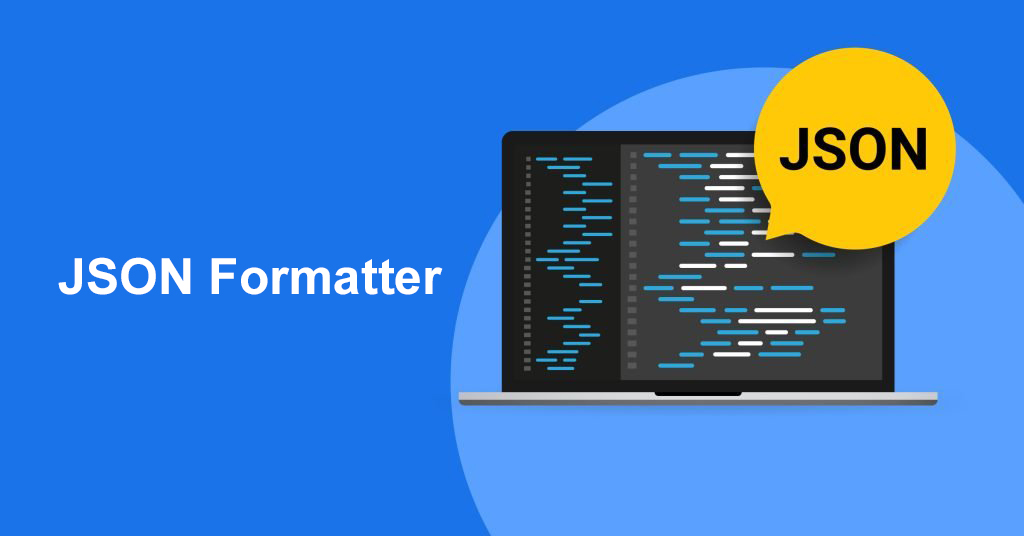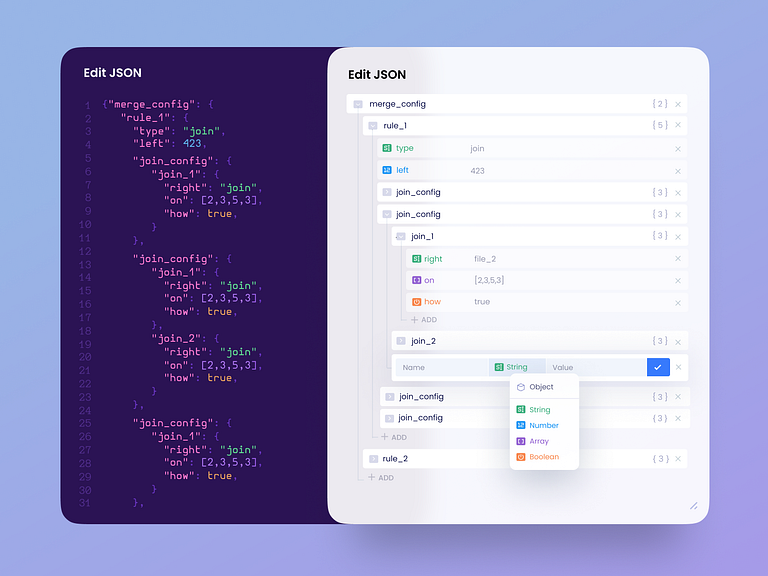JSON Formatter
The JSON Formatter tool allows you to format and beautify JSON data, providing a clear and readable structure with instant results. This tool is perfect for developers, data analysts, and anyone who works with JSON data and needs to improve its readability and organization. The process is simple and efficient, ensuring your JSON data is formatted correctly every time.
Result
Share on Social Media:
Ultimate JSON Formatter Tool: Beautify, Edit & Validate Your Code with Ease
Need a quick way to organize your JSON data? A json formatter efficiently beautifies, validates, and edits, enhancing readability and correctness. Join us as we unpack the key features of top json formatters and reveal how the right tool can immediately improve your coding practice.
Key Takeaways
The JSON Formatter by PagesTools.com provides features like auto-indentation, syntax highlighting, and error detection to enhance the readability and structure of JSON data across various browsers.
JSON (JavaScript Object Notation) is a lightweight, text-based format ideal for data interchange with consistent and language-independent structure, supported by a variety decreased of syntax and types.
Advanced JSON editing tools, including online editors, validators, and interactive viewers, facilitate efficient management, visualization, and validation of JSON files, ensuring accurate and easy-to-read data representation.
Exploring JSON Formatter by PagesTools.com

Dive into the world of JSON formatting with the online JSON formatter tool provided by PagesTools.com, a creation that epitomizes efficiency and precision. This tool is your reliable companion for editing and formatting JSON data, offering a native editing experience that brings clarity to even the most complex data structures. Its wide compatibility ensures that whether you’re using a cutting-edge browser or a tried-and-true one, your JSON editing endeavors will be seamless and productive.
But what truly sets this formatter apart is its ability to enhance user productivity. With features that streamline the formatting of JSON code, you’ll find that tasks which once took hours can now be accomplished in mere minutes. It’s not just about making your JSON pretty; it’s about transforming it into a model of readability and structure that can be effortlessly understood and manipulated.
Understanding JSON: The Basics
JSON, or JavaScript Object Notation, is a cornerstone of web development, originally derived from JavaScript’s object syntax. Its lightweight and text-based structure make it an ideal format for data interchange, breathing life into the communication channels between servers and browsers. With JSON, data is not only transmitted efficiently but is also human-readable, a trait that greatly simplifies debugging and maintenance. The JSON specification ensures consistency in the format and structure of JSON data, making it a reliable choice for developers. One common way to represent JSON data is through a JSON string, which can be easily parsed and manipulated.
At the heart of JSON are its syntax and data types, which include:
strings
numbers
arrays
booleans
object literals
This rich tapestry of types enables developers to construct hierarchical data structures that are both flexible and powerful.
Whether stored as a string with a .json extension or transmitted across network protocols, JSON’s independence from programming languages makes it a universally embraced data format for representing structured data.
How to Format JSON with Precision

Formatting JSON is not just about making it look better; it’s about enhancing its readability and ensuring that the structure of your data is clear and interpretable. Precision formatting tools such as auto-indentation, syntax highlighting, and error detection are indispensable in achieving this goal.
Let’s delve into how these features can transform your JSON from a jumble of text into a beautifully organized masterpiece.
Auto-Indentation for Clarity
The clarity of your JSON structure can be dramatically improved with the simple act of auto-indentation, a feature that any seasoned JSON beautifier worth its salt possesses. Imagine each nested object and array neatly indented and separated, providing a visual map of your data’s hierarchy. This not only aids in comprehension but also makes navigating through complex JSON documents a breeze.
By incorporating line numbers and newlines in the right places, auto-indentation ensures that each value and array is distinct and easily traceable. This level of formatting is particularly useful when you’re working with large JSON files, where the structure can get lost amid the volume of data. Auto-indentation brings order to chaos, allowing you to focus on the data itself rather than getting bogged down by its presentation.
Syntax Highlighting and Error Detection
Syntax highlighting is the splash of color in a monochrome world of code, providing visual cues that differentiate various elements within your JSON data. This feature is especially useful in languages like JavaScript, where the distinction between properties and strings is crucial. By emphasizing the need for double quotes around strings and property names, syntax highlighting ensures your JSON adheres to the specification and is ready for parsing.
But it’s not just about aesthetics; syntax highlighting is a powerful ally in error detection. When you paste your string into the formatter, any missing quotes or formatting errors come to light like a beacon, guiding you towards a quick fix. This kind of immediate feedback is invaluable for debugging and can save you hours of searching for that elusive typo or misplaced bracket.
Copying and Saving Formatted JSON
Once your JSON is polished to perfection, you’ll want to ensure that it’s preserved for future use. The JSON formatter tool offers a convenient feature for saving your formatted data right within your browser’s local storage. Think of it as a notepad that’s always at your fingertips, ready to store and retrieve your JSON with just a few clicks.
This local storage acts as a safety net, providing a quick and easy way to edit and access your JSON in subsequent sessions. Whether you’re midway through a project or need to revisit a piece of code down the line, your formatted JSON is safely tucked away, ready to be called upon whenever you need it.
Editing JSON Files Online: A Simplified Process
The era of cumbersome JSON editing is over. Modern online JSON editors, like the one offered by PagesTools.com, boast dual panels that enable you to view and edit multiple JSON documents side by side, streamlining the comparison and synchronization process. With these tools, you can switch between code mode, which allows for granular editing of raw text, and tree mode, which abstracts the JSON structure for easier manipulation of elements within large documents.
Handling JSON files of substantial size is no longer a Herculean task. These editors are engineered to manage documents up to 512 MB, providing quick search and query functions that cut through the data like a knife through butter. Real-time updates to visualizations mean that as you edit, you can immediately see the impact of your changes, ensuring accuracy and efficiency in your JSON workflow.
Visualizing JSON: Interactive JSON Viewer

Witness your JSON data come to life with an interactive JSON viewer. These viewers provide a hands-on approach to understanding data structures, allowing you to expand or collapse nodes at will. With the ability to process large files, you can effortlessly navigate through complex hierarchies, turning intimidating JSON data into a navigable landscape.
Interactive viewers go beyond simple tree diagrams; they offer dynamic graph representations that elucidate the relationships within your data. Visualizing JSON in this way can be particularly helpful when previewing multimedia content directly within the data or when analyzing data patterns through various chart formats. This level of interactivity makes the JSON viewer an indispensable tool in any data analyst’s arsenal.
Validating JSON: Ensuring Accuracy
Accuracy is non-negotiable when it comes to JSON data. Validation tools are your safeguard against errors that could derail your application. These tools not only ensure that your JSON meets the stringent standards required for parsing but also provide detailed error messages to help you quickly address any issues.
Some popular JSON validation tools include:
JSONLint
JSON Schema Validator
JSON Validator
JSONMate
Using these tools will help you validate JSON data and ensure its accuracy, making it essential to validate JSON in your projects.
Imagine having a vigilant sentinel that highlights errors in your JSON files, pointing out precisely where you’ve gone astray. With validators like JSONLint, you can scrutinize your content against JavaScript standards and make corrections with confidence, thanks to clear indications and line numbers.
Whether it’s a subtle syntax mistake or a glaring structural error, these tools will help you clean up your JSON and keep your data integrity intact.
JSON Beautifier: From Messy to Readable
Confronted with a messy JSON file? Fear not, for the JSON beautifier is here to rescue your data from the depths of disarray. With a simple copy and paste, followed by a click of the beautify button, your once cluttered JSON is transformed into a work of art. The output is not just a string of human-readable text; it’s a testament to the power of well-formatted code, thanks to the json cleaner.
Customization is at your fingertips, with options to adjust indentation levels to suit your personal style. Once beautified, the JSON is primed for integration with your favorite text editors, such as Notepad++, Sublime, or VSCode, making it a breeze to incorporate into your existing projects.
Transforming Data: JSON to CSV and Beyond
Data transformation is a critical aspect of data management, and the ability to convert JSON to CSV opens up a world of possibilities for storage and analysis. With a few clicks, you can:
Upload a JSON file
Paste its text into an online converter
Watch as it metamorphoses into a neatly organized CSV file, ready for spreadsheets or databases.
The process is intelligent and adaptable, handling complex nested structures with ease and allowing you to map JSON keys to CSV columns. Batch processing and advanced settings further enhance the conversion, ensuring that your large datasets are processed efficiently and precisely.
Once the conversion is complete, a prompt to download the CSV file is your cue that your data is ready for its next adventure.
Boost Your JSON Workflow with Advanced Features
Take your JSON workflow to the next level with advanced features that not only validate your data but also provide the ability to repair and correct common errors. The JSON Formatter tool is designed to cater to your specific needs, accommodating large files and integrating complex logic and calculations into your editing process.
The integration of JavaScript logic allows for dynamic changes and styling control, while adherence to the JSON Schema ensures that your documents meet defined standards. These features collectively support a consistent and validated data pattern, vital for maintaining the integrity of your JSON documents.
Secure and Private: Data Policy for Your JSON Files
Security and privacy are paramount in the digital age, and the JSON Formatter tool by PagesTools.com takes this to heart. With a robust data policy in place, you can rest assured that your JSON documents are protected and accessible only to you. The role-based access policies defined in policy.json files ensure that your data is shielded from unauthorized eyes, and changes to these policies can be implemented dynamically while the service is running.
Subscribers to the JSON Editor Online service enjoy the benefits of a secure environment that is ad-free and devoid of cookies and tracking. Public cloud documents are accessible via a unique ID, but it is advisable not to store sensitive data in the cloud to maintain the highest levels of privacy and security.
Tailored User Experience: Customization Options
Your workspace should be as unique as you are, and the JSON Formatter tool by PagesTools.com understands that. With theme customization options, you can switch between light and dark modes to match your mood or working conditions. The interface isn’t just functional; it’s an extension of your personal style.
Font customization takes this personalization further, allowing you to apply different font families to various elements of the interface. Whether you prefer the classic serifs or the sleekness of sans-serif fonts, the tool’s customization capabilities let you set default fonts for text elements, ensuring a comfortable and tailored editing experience.
Compatibility Across Platforms
In today’s digital ecosystem, cross-platform compatibility is not just a luxury; it’s a necessity. The JSON Formatter tool by PagesTools.com rises to the occasion, offering a tool that works flawlessly across Windows, Mac, and Linux. Whether you’re working from the comfort of your home or on the go, this tool is always within reach.
The tool’s web-based design means that any device with a web browser can access it without the hassle of installing additional software. Major browsers such as:
Chrome
Firefox
Safari
Edge
are all supported, ensuring that regardless of your preferred browser or platform, the JSON Formatter tool is ready for you.
Summary
Throughout this exploration, the JSON Formatter tool by PagesTools.com has demonstrated its ability to simplify and enhance the JSON workflow. From beautifying cluttered data to providing advanced editing features and ensuring your data’s security and privacy, this tool is a testament to the innovation in data management. Compatibility across multiple platforms and browsers further cements its place as an indispensable asset for developers and data enthusiasts alike.
Let this be your call to action - embrace the JSON Formatter tool and witness the transformation in your productivity and the quality of your JSON data. With this tool at your disposal, you’re not just working smarter; you’re shaping the future of data handling with precision, efficiency, and confidence.
Frequently Asked Questions
What is JSON and why is it important?
JSON is important because it is a universal data format that simplifies the exchange of information across different platforms and programming languages, making it widely used in web development. It is a lightweight data interchange format that is easy for humans to read and write, and easy for machines to parse and generate.
How does auto-indentation improve JSON readability?
Auto-indentation improves JSON readability by automatically adding indentation and line breaks, creating a clear, hierarchical structure of the data. This makes understanding the relationships between different elements and navigating through the JSON document easier, particularly with large or complex data structures.
Can I use the JSON Formatter tool on any operating system or browser?
Yes, you can use the JSON Formatter tool on any operating system and browser, as it is compatible with Windows, Mac, Linux, and major web browsers like Chrome, Firefox, Safari, and Edge. Its web-based design enables access from any platform with a web browser.
Is it secure to use online JSON editors and formatters with sensitive data?
It is generally not secure to use online JSON editors and formatters with sensitive data due to the risks associated with storing such information on public cloud storage. Look for services that provide role-based access, encryption, and local storage for added security.
What advanced features does the JSON Formatter tool provide to enhance workflow?
The JSON Formatter tool provides advanced validation, auto-correction of JSON errors, the ability to repair broken JSON documents, supports large files up to 512 MB, and integrates dynamic calculations, complex logic application, and enhanced styling control through JavaScript logic, all enhancing JSON editing workflow.